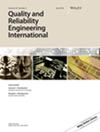基于期望最大化算法的竞争风险下反威布尔分布的参数估计
IF 2.2
3区 工程技术
Q3 ENGINEERING, INDUSTRIAL
引用次数: 0
摘要
我们正在研究一个由相互连接的串联部件组成的系统。本研究的重点是在竞争风险的框架内,利用基本的反向威布尔分布,对该系统的不完整寿命数据进行参数估计。虽然一种常用的参数估计方法是牛顿-拉斐森(NR)技术,但它对初始值选择的敏感性是一个重大缺陷,经常导致收敛失败。因此,本文选择了期望最大化(EM)算法。在竞争风险情景中,失败的确切原因往往无法确定,而这些问题可能因潜在的普查而变得更加复杂。因此,普查和掩蔽都可能导致不完整性。在本研究中,我们提出了 EM 型参数估计方法,并证明其优于基于 NR 方法的参数估计。本文提供了两个示例。我们将提出的方法与现有的 Weibull 竞争风险模型进行了比较,结果显示了我们方法的优越性。通过蒙特卡罗模拟,我们还考察了 NR 型方法和我们提出的方法对初始值选择的敏感性。本文章由计算机程序翻译,如有差异,请以英文原文为准。
Parameter estimation of inverse Weibull distribution under competing risks based on the expectation–maximization algorithm
A system consisting of interconnected components in series is under consideration. This research focuses on estimating the parameters of this system for incomplete lifetime data within the framework of competing risks, employing an underlying inverse Weibull distribution. While one popular method for parameter estimation involves the Newton–Raphson (NR) technique, its sensitivity to initial value selection poses a significant drawback, often resulting in convergence failures. Therefore, this paper opts for the expectation–maximization (EM) algorithm. In competing risks scenarios, the precise cause of failure is frequently unidentified, and these issues can be further complicated by potential censoring. Thus, incompleteness may arise due to both censoring and masking. In this study, we present the EM‐type parameter estimation and demonstrate its superiority over parameter estimation based on the NR method. Two illustrative examples are provided. The proposed method is compared with the existing Weibull competing risks model, revealing the superiority of our approach. Through Monte Carlo simulations, we also examine the sensitivity of the initial value selection for both the NR‐type method and our proposed method.
求助全文
通过发布文献求助,成功后即可免费获取论文全文。
去求助
来源期刊
CiteScore
4.90
自引率
21.70%
发文量
181
审稿时长
6 months
期刊介绍:
Quality and Reliability Engineering International is a journal devoted to practical engineering aspects of quality and reliability. A refereed technical journal published eight times per year, it covers the development and practical application of existing theoretical methods, research and industrial practices. Articles in the journal will be concerned with case studies, tutorial-type reviews and also with applications of new or well-known theory to the solution of actual quality and reliability problems in engineering.
Papers describing the use of mathematical and statistical tools to solve real life industrial problems are encouraged, provided that the emphasis is placed on practical applications and demonstrated case studies.
The scope of the journal is intended to include components, physics of failure, equipment and systems from the fields of electronic, electrical, mechanical and systems engineering. The areas of communications, aerospace, automotive, railways, shipboard equipment, control engineering and consumer products are all covered by the journal.
Quality and reliability of hardware as well as software are covered. Papers on software engineering and its impact on product quality and reliability are encouraged. The journal will also cover the management of quality and reliability in the engineering industry.
Special issues on a variety of key topics are published every year and contribute to the enhancement of Quality and Reliability Engineering International as a major reference in its field.

 求助内容:
求助内容: 应助结果提醒方式:
应助结果提醒方式:


